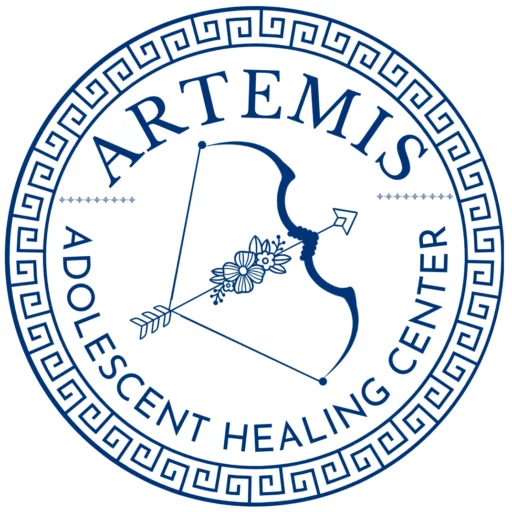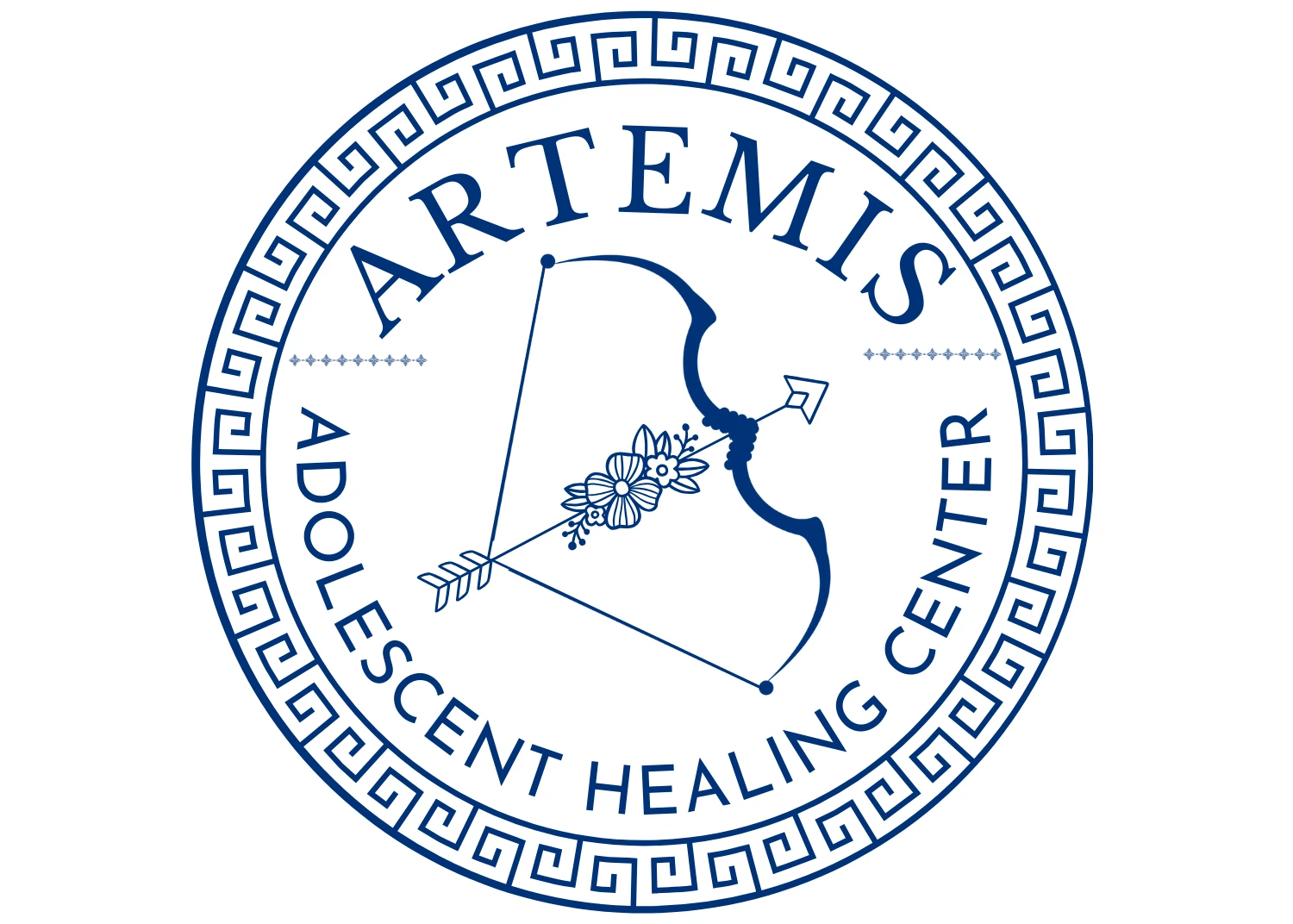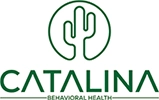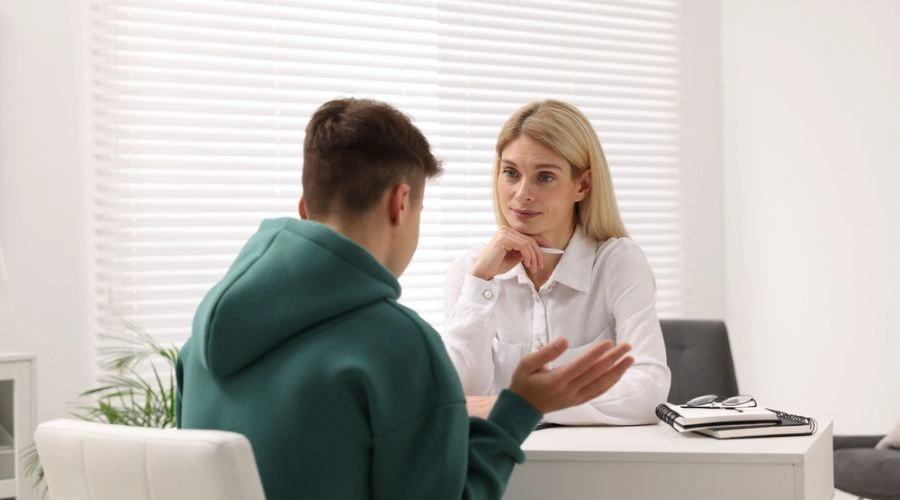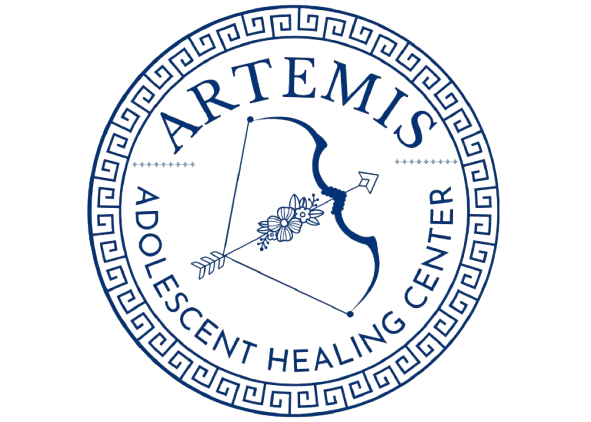Find Obsessive Compulsive Disorder Treatment Support for Teenagers With OCD at Artemis
Finding OCD treatment for teens can sometimes be a bit tricky. Adult programs don’t generally accept clients under 18, while a child’s treatment process may focus on tweens or younger children. Few programs offer a customized treatment plan for teenagers aged 13 to 18.
That’s Artemis Adolescent Healing Center’s sweet spot; we specialize in helping teens and young adults suffering from OCD and other mental illnesses. If a daily struggle with the distressing thoughts and compulsive actions of obsessive-compulsive disorder interferes with your teen’s daily functioning, our certified and accredited therapists can help.
Treating OCD in adolescents at Artemis addresses the unique concerns of adolescents while providing the intensive treatment needed to stop those recurring OCD symptoms. Our mental health professionals work closely with parents and caregivers and use evidence-based therapy and holistic approaches to their well-being. We invite you to read on to learn more about receiving treatment.
Get Confidential OCD Assessment at Artemis
Obsessive Compulsive Disorder (OCD) in Teens
Obsessive-compulsive disorder (OCD) is a chronic mental health condition. It traps people into a cycle of obsessions, or unwanted thoughts and compulsions, repetitive behaviors, or mental rituals they use to relieve the distressing thoughts.
When it occurs in teens, OCD symptoms can impact school, self-esteem, and personal relationships. Many teenagers feel ashamed or confused by their diagnosis and hide it from people when possible. But without treating OCD, it can get worse and soon become impossible to hide.
Common OCD Symptoms in Teenagers
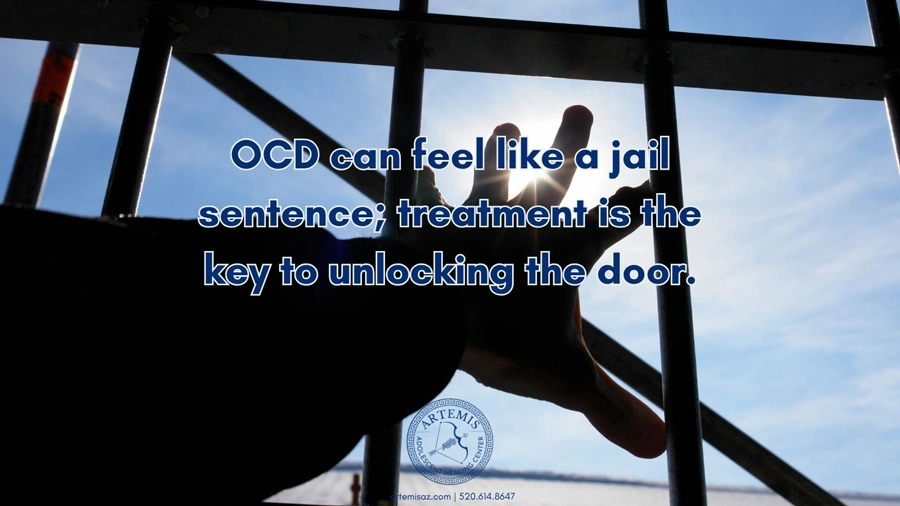
No two people with obsessive-compulsive disorder experience it in precisely the same way. Here are some common symptoms to know:
- Excessive handwashing or cleaning that goes beyond general hygiene
- Checking rituals, including things like turning off the appliances or locking car doors
- Counting, tapping, and repeating actions a certain number of times
- Fearing contamination from harmless surfaces
- Excessive expectations of symmetry or things in a particular order
- Intrusive, obsessive thoughts, which can be disturbing or violent
- Asking family members for constant reassurance that things are okay
- Avoidance of certain people or places that trigger OCD behaviors
- Spending excessive time on routines, sometimes interfering with completing homework, attending school, or sleeping
- Emotional outbursts and irritability
- Discusses the compulsive behaviors
- Physical exhaustion or stress because of managing the rituals
- Grades are falling
- Withdrawing from friends or loved ones in the adolescent’s life
- Loved ones getting drawn into the rituals, such as helping the teen avoid specific triggers
These are the most frequent OCD symptoms. However, other symptoms can also occur in more severe OCD, including obvious signs like skin-picking disorder.
Are Your Teen’s Routines a Sign of OCD?
Typical routines become problematic when they become rigid, distressing, or interfere with the teen’s quality of life. If your teenager gets anxious because of routine disruptions or spends hours doing repetitive behaviors, they could have OCD, not just a quirky routine.
Diagnosing OCD: What Family Members Need to Know
A licensed, qualified mental health specialist must assess the teen for OCD as soon as parents notice the symptoms. Because the OCD experience is usually mild at first, those in the family system may not notice it at first.
For example, they might see frequent handwashing and think the adolescent is finally following parental advice and helping prevent the spread of the flu.
But when things progress beyond that, you need to get a professional evaluation for OCD and other disorders. Early diagnosis is empowering. A clinical assessment allows you to find a professional program to provide education, resolve specific phobias, and restore functional daily life.
Adolescent OCD Types That May Appear
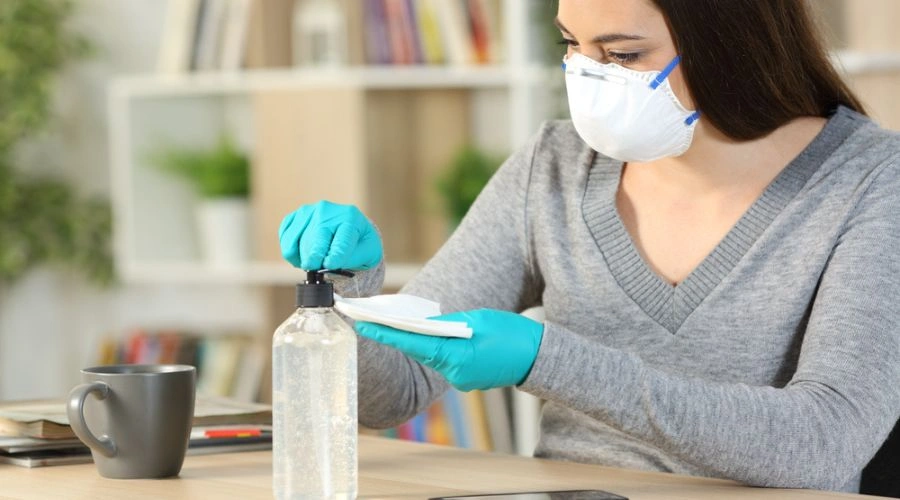
Obsessive-compulsive disorder isn’t a ‘one-size-fits-all’ disorder. It encompasses several subtypes, although not all are common in adolescent OCD. Here are some of the types teens might experience:
- Contamination fears
- Checking things
- Symmetry obsessions
- Taboo intrusive thoughts
- Perfectionism
- Moral/religious obsessions
Our compassionate team can help deliver customized treatment plans to help your teen overcome the intense anxiety and disruptive thoughts in a supportive environment. We give our clients all the tools they need to make significant improvements.
Get Accredited Treatment Programs at Artemis
Treatment Approaches in Adolescent OCD Treatment
The next sections discuss some of the treatment programs effective in treating OCD in teens. Each program is custom-tailored to address adolescent OCD, and not all teens will receive all of the treatment options.
It’s also important to know that some treatments will be individual; others may be group therapy activities, ensuring adolescents have the opportunity to build skills with their peers.
Exposure and Response Prevention (ERP Therapy)

Exposure and response prevention (ERP therapy) gradually exposes teens to their triggers or fears while preventing them from acting on the compulsive behaviors. Sometimes shortened to exposure therapy, this treatment improves over several sessions. Many psychologists and family therapists call it the ‘gold standard‘ of OCD treatment.
Example: ‘Liam,’ 16, spend hours of his day checking that all the lights were off, convinced that this ritual would prevent the house from burning down. With the help of our therapists, Liam gradually faced his fears without continuing to perform rituals. He can now go to school without being distracted by his fear.
Acceptance and Commitment Therapy and OCD Recovery
Acceptance and commitment therapy, or ACT, helps teens with OCD learn to accept their obsessive thoughts without judgment, replacing them with meaningful goals that align with their personal values. ACT helps them learn to stop fighting intrusive thoughts, accept them, and move past them.
Example: ‘Maria,’ 14, had thoughts intruding on her brain, interfering with her schoolwork. She couldn’t stop them without mental rituals. ACT helped Maria observe and process these thoughts so she could study hard – she wanted to attend Yale Law School someday.
Cognitive Behavior Therapy (CBT)
Cognitive behavioral therapy (CBT) is key in treating OCD and is safe for teens. CBT helps teens and young adults identify unhelpful thoughts and challenge them. Once they know how to respond to the intrusive thoughts without responding, the OCD symptoms improve.
Example: ‘Noah,’ 15, believed that something horrible would happen to his family if he didn’t recite a particular mantra. In CBT, Noah learned to identify those distorted thoughts and change them. Now he knows how to reframe his thoughts and feels less anxious.
Dialectical Behavior Therapy (DBT)
DBT was not designed for OCD. However, it can be a helpful enhancement for teens whose OCD causes them to struggle with intense emotions, social anxiety, or thoughts of self-harm. Dialectical behavioral therapy helps develop emotional regulation, mindfulness, and distress tolerance, which can indirectly support OCD treatment.
Example: ‘Jazz,’ 17, had OCD with intense mood swings and thoughts of self-harm. DBT helped her learn to manage her emotions and tolerate mild distress without the urge to hurt herself. She now has the tools to stop those obsessive spirals from gaining steam and pulling her into the abyss as soon as they occur.
Medication Management in OCD Treatment
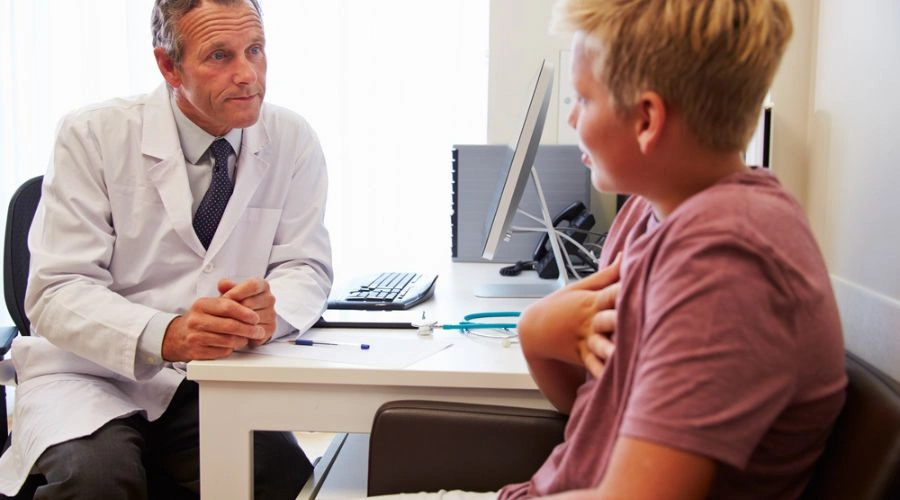
Doctors often prescribe FDA-approved prescription medications for people whose obsessive-compulsive disorder symptoms persist despite treatment. Our psychiatrist works closely with the entire treatment team and integrates medications with other prescriptions the teen might take. This attention ensures that the teen benefits from all medications without drug interactions.
Example: ‘Eli,’ 13, struggled with OCD about contamination, which started because of his asthma but quickly became over the top. After CBT psychotherapies alone couldn’t stop him from acting on handwashing compulsions, the doctor added a prescription that didn’t impact the effectiveness of his asthma medications.
Holistic Treatments for Whole Person Healing
OCD takes a toll on both the teen’s physical and mental health. A well-rounded, holistic treatment program encompassing whole-person healing is critical. Besides the science-backed psychological therapy (ERP, CBT, etc.), your teen may engage in:
- Experiential activities
- Nutritional programs
- Yoga
- Music therapy
- Art therapy
- Exercise programs
Our goal is for your teen to experience complete body and mind healing.
Example: ‘Aiyana,’ 16, felt disconnected from her identity because of the overwhelming OCD rituals that included counting and orderliness. Artemis helped Aiyana by introducing her to traditional arts and crafts, which provided an outlet for her to express her feelings and also reconnected her with her Native American identity.
The Importance of Family Therapy in Treating Teen OCD
Family is the key to lasting recovery after the teen leaves outpatient treatment or their residential program. Parents and siblings may have unwittingly reinforced OCD behaviors in the past, making things worse when they had only intended to help. Led by specially trained counselors, families learn to have open conversations, set boundaries with one another, and support full recovery.
OCD and Co-Occurring Mental Health Disorders

OCD sometimes exists alongside another mental health concern. We often see these co-occurring disorders in teens and adult clients:
- Generalized anxiety disorder
- Panic attacks
- Eating disorders
- Major depression
- Substance use disorder
- Mood disorders
We work hard at the beginning of the teen’s OCD treatment to identify these, if any exist. Early diagnosis helps us gain insight to other factors impacting OCD, allowing us to adjust treatment plans to address both components.
Why Specialized Adolescent Services Work Better Than Adult Models
Treatment plans for teens with OCD use different language, coping tools, and pacing than those for adults. Our therapists work closely with teens to build trust and rapport. We also ensure that the approaches integrate well with a teen’s daily life, including school, part-time jobs, or family life.
Residential vs. Outpatient OCD Treatment Options for Teens
You might wonder if your teen needs a more intensive residential treatment program or if outpatient obsessive-compulsive disorder treatment will work better. Both approaches have merit, and the answer lies in the severity of the teen’s symptoms.
A residential treatment program is most suitable for teens who need a highly structured, supportive environment. If the OCD is so severe that they can’t function or complete simple tasks, or if they have a debilitating co-occurring disorder or thoughts of self-harm, residential treatment might be the best option.
Adolescent OCD, especially when treated in the earliest stages, is more often treated in an outpatient setting. The treatment plan is still comprehensive and can address obsessive-compulsive disorder and mild co-occurring anxiety disorder, depression, and more without the time commitment of residential treatment.
Teen OCD vs. Typical Teen Behavior: When to Worry
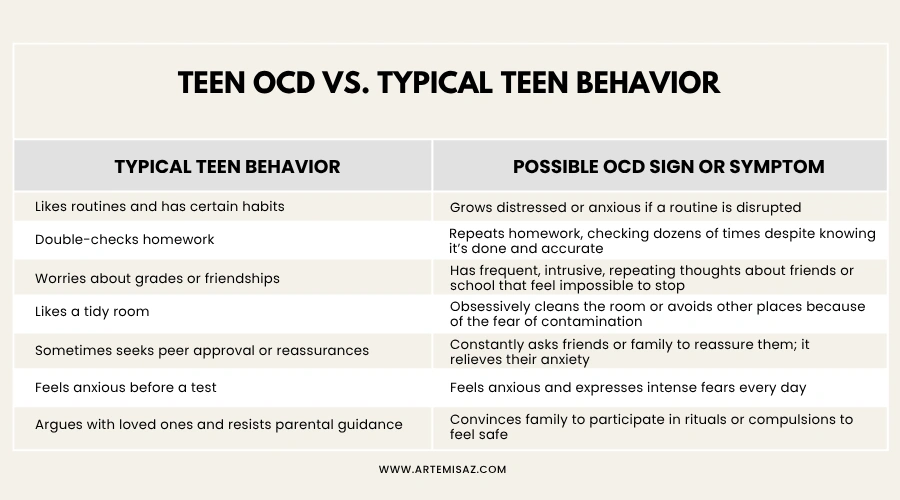
Teens undergo natural growth phases where they may intensely focus on a new hobby, quirky habits, or emotional ups and downs. However, when their behaviors become obsessions and interfere with their ability to function, it may be more serious.
Seeking early treatment is the key to improving adolescent OCD. Look for therapists, support groups, and other resources to confront OCD, anxiety disorder, or other symptoms right away.
Here’s a side-by-side comparison to help identify what behaviors are typical and which should raise red flags:
| TYPICAL TEEN BEHAVIOR | POSSIBLE OCD SIGN OR SYMPTOM |
| Likes routines and has certain habits | Grows distressed or anxious if a routine is disrupted |
| Double-checks homework | Repeats homework, checking dozens of times despite knowing it’s done and accurate |
| Worries about grades or friendships | Has frequent, intrusive, repeating thoughts about friends or school that feel impossible to stop |
| Likes a tidy room | Obsessively cleans the room or avoids other places because of the fear of contamination |
| Sometimes seeks peer approval or reassurances | Constantly asks friends or family to reassure them; it relieves their anxiety |
| Feels anxious before a test | Feels anxious and expresses intense fears every day |
| Argues with loved ones and resists parental guidance | Convinces family to participate in rituals or compulsions to feel safe |
Up To 100% of Rehab Costs Covered By Insurance
Call Artemis Adolescent Healing Center for OCD Treatment
A teen struggling with the cycle of unwanted thoughts and compulsions of OCD can begin to have less success in school, relationships, and life. Working with a therapist at Artemis can provide the relief and healing needed to restore the teen’s peace of mind. Call us today and learn how we can help – your inquiry is confidential.
